The best AV receivers in 2024 Popular Science We’ve rounded up some of the best AV receivers available. Check out what makes these AV receivers stand out and find the perfect one for you! These audio-video receivers give you vast connectivity for all your sources. By Mike Levine Updated on Oct 26, 2023 4:15 PM EDT Marantz Cinema 70S See It Sony STR-AN1000 See It Denon AVR-S570BT See It - We considered dozens of the best AV receivers and amplifiers for this story and focus on those that offer overall excellence in their price range.

We’ve rounded up some of the best AV receivers available. Check out what makes these AV receivers stand out and find the perfect one for you! These audio-video receivers give you vast connectivity for all your sources.
By Mike Levine
Updated on Oct 26, 2023 4:15 PM EDT

Marantz Cinema 70S
See It 
Sony STR-AN1000
See It 
Denon AVR-S570BT
See It -
We considered dozens of the best AV receivers and amplifiers for this story and focus on those that offer overall excellence in their price range. We also wanted to present products that excel for specific applications, such as gaming or audiophilemusic listening or multichannel surround sound. All our recommended units are made by solid, reputable companies and should give you years of excellent performance. The PopSci writers and editors have decades of combined experience writing about technology and home theater gear. These recommendations are a mixture of first-hand experience, spec comparisons, user impressions, peer recommendations, and scouring critical AV receiver reviews.
The best AV receivers: Reviews & Recommendations
The best AV receivers integrate the various components of your home theater and music system. Most offer optical and analog (RCA) inputs in addition to their HDMI ports. That way, AVRs can incorporate digital sources like Blu-ray players, streaming devices, game consoles, smart TVs, analog turntables (although you might need a phono preamp), or older CD or DVD players. AVRs receive audio over the internet (some by WiFi and others Ethernet) and via Bluetooth from your mobile devices; many can provide wireless multiroom audio. A home theater with a music system and maybe a gaming system would be unmanageable without an AV receiver as its nerve center. You can assume that each AVR we mention includes a remote control and a setup/calibration system.
Best overall: Marantz Cinema 70S
Best audiophile AV receiver
An AVR for Discriminating Listeners
 See It
See It
An AVR for Discriminating Listeners
 See It Why it made the cut: Get it for the Marantz sound quality and enough channels for true Dolby Atmos.
See It Why it made the cut: Get it for the Marantz sound quality and enough channels for true Dolby Atmos.
Specs
- Channels: 7.2
- Power: 50W per channel (into 8 Ohms, THD: 0.07%, 2-ch driven)
- HDMI ports: 6in/1 out
- Highest Video Supported: 8K
Pros
- High-quality Marantz audio
- Dolby Atmos and DTS:X, both hardWPT123 and virtual.
- Built-in HEOS
Cons
- Remote lacks backlight
Marantz’s 70S packs the performance of a full-sized AV receiver into a package compact enough to fit in most media centers. It supports Dolby Atmos audio, can pass through Dolby Vision video at 8K, and even has a built-in phono preamp.
In our tests, the Cinema 70S was surprisingly simple to set up. We plugged in our Q Acoustics 3020i bookshelf speakers and Q Acoustics 3050i towers, connected the receiver to a Sony OLED 55-inch BRAVIA XR A80L Series 4K Ultra HD TV using an HDMI cable, and followed the on-screen instructions, which walked us through testing each speaker to ensure it was connected correctly. We could also connect the receiver to our WiFi network using a pair of included antennas, enabling the ability to stream media from Apple devices using AirPlay 2. There’s also a built-in Ethernet port if you’d prefer to hardwire your setup completely. Within 15 minutes of unboxing the sleek but substantial feeling receiver, we were up and running.
We filled most of the Cinema 70S’ HDMI inputs with all three current-generation game consoles, the latest Apple TV 4K, and connected a Denon DCD-900NE CD player to one set of its RCA inputs. We had no problem using the Apple TV to stream Dolby Atmos tracks, playing Xbox Series X games like Diablo IV with Dolby Vision enabled, and enjoying every bit—pardon the pun—of our CD collection through Denon’s latest player. There were no ticks or dropouts during our hours of playing and listening, either.
Devices connected to the Cinema 70S over HDMI have the ability to wake the receiver and TV using their respective remotes, which makes jumping into a game or using the Apple TV to stream media more convenient. The receiver always recognized when a device was turned on and automatically switched to the correct input. We could tell this was true because the receiver would show the connected device’s name (and its current volume level) on the tiny screen built into its circular portal-like screen.
Overall, we were incredibly pleased with how well Marantz’s Cinema 70S performed under several circumstances, and its variety (and quantity) of inputs mean it’ll likely be your one-stop shop for both analog and digital music listening and video watching. Some nice-to-have features (like backlit buttons on its remote) were missing, but the core functionality far exceeded our expectations, especially given its incredibly reasonable size.
Best 4K under $500: Yamaha RX-4VA
Best AV receiver under $500
A Lot for Less
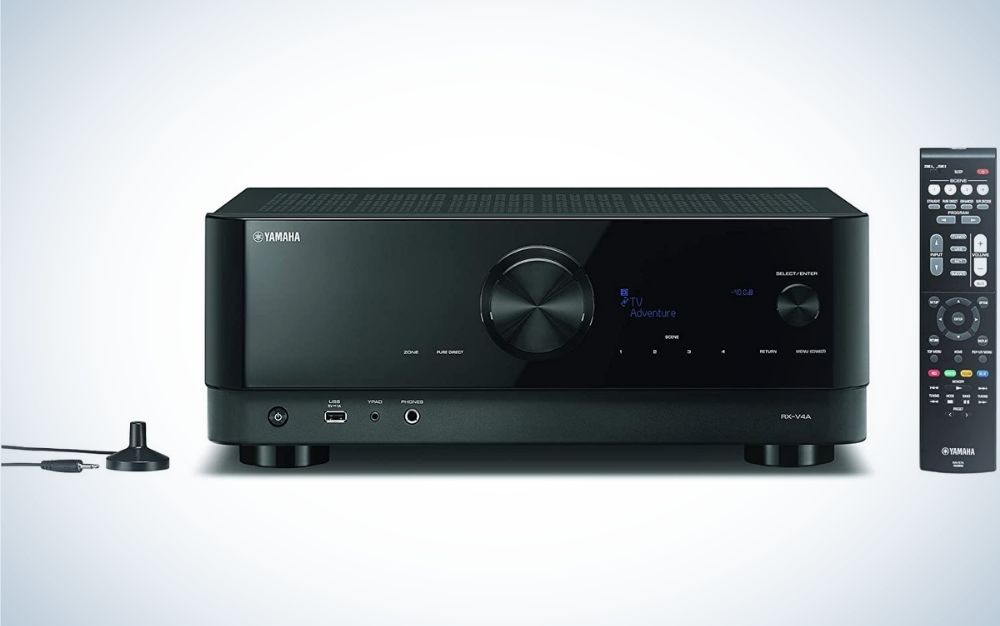 Solid features for the money, including future support of 8K. See It
Solid features for the money, including future support of 8K. See It
A Lot for Less
 Solid features for the money, including future support of 8K. See It Why it made the cut: It offers a surprisingly rich feature set for the money if you don’t need every bell and whistle.
Solid features for the money, including future support of 8K. See It Why it made the cut: It offers a surprisingly rich feature set for the money if you don’t need every bell and whistle.
Specs
- Channels: 5.2
- Power: 80W per channel (into 6 ohms, 0.06% THD)
- HDMI ports: 4 in/1 out
- Highest video supported: 4K currently, 8K upgrade via firmware available soon
Pros
- Affordable price for a surround-capable receiver
- Supports multiple video and music formats
- Will support 8K and VRR, QMS, ALLM and QFT with a future firmware update
Cons
- Requires (free) HDMI board replacement for 4K/120Hz gaming
- No Dolby Atmos height virtualization or DTS Virtual:X support
- No phono input
This 5.2-channel unit makes a solid centerpiece for home theater, gaming, and music listening. With four HDMI 2.1 inputs and an eARC output—along with optical, coaxial, and analog RCA inputs (but no phono inputs for a turntable)—it’s compatible with a wide range of gear. The unit supports Dolby and DTS surround sound decoding, streaming via WiFi, Apple AirPlay 2, and Spotify Connect, and can be voice-controlled with Amazon Alexa or Google Assistant.
The RX-4VA comes with Yamaha’s MusicCast multiroom system (minus the speakers, of course), allowing you to connect with other compatible Yamaha components wirelessly. A USB port lets you play music from an external storage device.
On the negative side, the RX-4VA doesn’t support virtualized Dolby Atmos or DTS Virtual:X. It’s also one of the receivers whose chipset has an HDMI 2.1 bug that cannot handle 4K/120Hz gaming for Xbox Series X or NVIDIA RTX30. Fortunately, Yamaha offers a free HDMI board update program to fix it. Although it supports HDMI 2.1, it doesn’t support 8K out of the box. However, Yamaha will soon offer a firmware update that will add 8K capabilities as well as VRR (Variable Refresh Rate), ALLM (Auto Low-Latency Mode), QMS (Quick Media Switching), and QFT (Quick Frame Transport), which are HDMI 2.1 features designed to enhance gaming. Together, this makes it a top-value 4K AV receiver that retails for $599 but is typically offered under $500 and is future-proofed for when 8K flatscreens come down to a more approachable price.
Best 7.2: Denon AVR-X2800H
Best AV receiver under $1,000
It’s got the goods
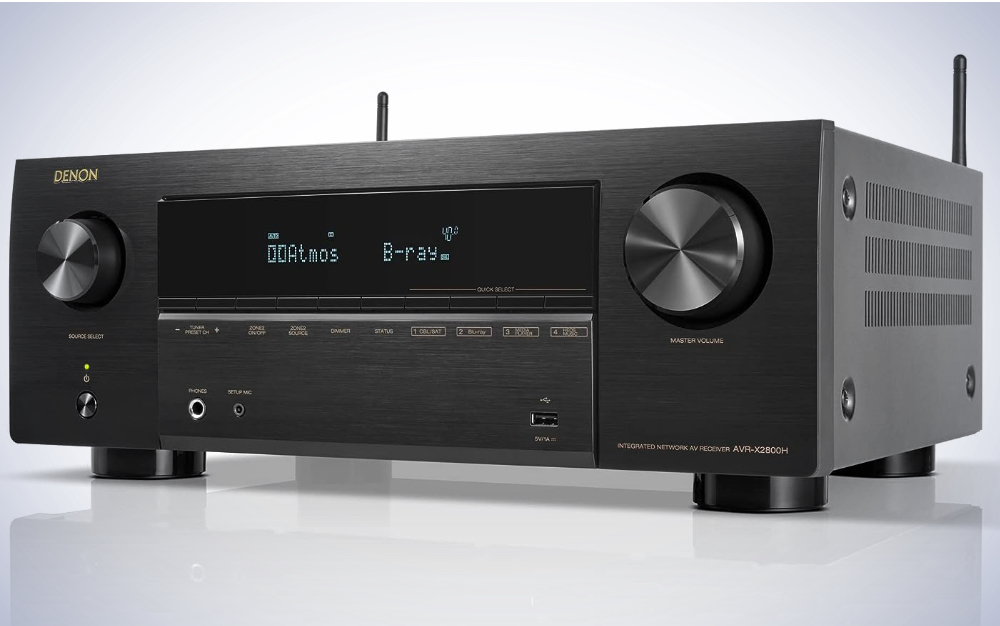 See It
See It
It’s got the goods
 See It Why it made the cut: This mid-priced AVR has a full feature set and is ready for the future.
See It Why it made the cut: This mid-priced AVR has a full feature set and is ready for the future.
Specs
- Channels: 7.2
- Power: 95W per channel (into 8 ohms, THD: 0.08%)
- HDMI ports: 6 in /2 out
- Highest video supported: 8K
Pros
- Broad multichannel format support
- Lots of connectivity options
- 8K video pass-through
Cons
- Dirac support requires jumping up to a higher-priced model
Surround sound used to be synonymous with 5.1 speaker configurations, but the advent of Dolby Atmos and other “3D” audio formats have helped usher in the era of 7.2 systems. Denon’s AVR-X2800H is well-equipped for this job, serving up a solid 90W of power per channel and supporting Dolby Atmos, Atmos Height Virtualization, DTS:X, DTS Virtual:X surround audio formats.
Virtual surround sound formats will never be able to usurp or equal the experience of additional physical speakers, but they’re nice to have as you build your setup. Beyond HDMI ports, the AVR-X2800H is stacked with RCA, optical audio, and coaxial inputs. There’s even a built-in phono preamp if you plan on hooking up your turntable to the receiver.
Audio is important when selecting the right AV receiver, but it’s only one-half of the equation. The AVR-X2800H also delivers on the “V” side of things by passing through 8K/60Hz or 4K/120Hz video and supporting the latest HDR formats, including Dolby Vision, HDR10+, and HLG. If you plug in a game console or 4K Blu-Ray player, you will like what you see and hear.
On the wireless connectivity front, the AVR-X2800H stacks up well, too. It supports Apple’s AirPlay, Bluetooth, HEOS, and can be integrated into Apple HomeKit or Google Assistant smart home ecosystems. It feels like the only protocol this receiver doesn’t support is Dirac Live, an optional piece of software that continuously analyzes your room to adjust and optimize your speakers’ output. If that sounds appealing, you’ll need to jump up to Denon’s AVR-X3800H, a 9.4-channel stereo receiver that’s even more immersive (but also pricier).
If you’re looking to expand your surround sound system beyond five channels and a single subwoofer, Denon’s AVR-X2800H should be your first choice.
Best for home theater:Arcam AVR31
Best high-end AV receiver
Master of Multichannel
 16-channels of processing See It
16-channels of processing See It
Master of Multichannel
 16-channels of processing See It Why it made the cut: It can process up to 16 channels of multichannel audio.
16-channels of processing See It Why it made the cut: It can process up to 16 channels of multichannel audio.
Specs
- Channels: 7.2
- Power: 120W per channel (into 8 ohms at 0.02% THD, 2-ch driven)
- HDMI ports: 7in/3 out (HDMI 2.1)
- Highest Video Supported: 8K
Pros
- 16 channels of processing
- Broad multichannel format support
- Dirac Live room correction tailors the sound to your room’s acoustics (microphone included)
- Class G amplification provides excellent sound
- Spotify Connect, TIDAL Connect, MQA, and Roon support
Cons
- No phono input for turntable two-channel use
- Price
Arcam’s high-end AV receiver offers seven Class G amplification channels, offering better efficiency than the typical Class B or AB designs. It also can process 16 channels simultaneously. Using its preamp-outs to feed an additional power amp, you could configure a 15.2 system. The AVR31 has Dirac Live room correction and a measurement mic to calibrate all those speakers correctly.
Moreover, it offers broad support of multichannel audio formats: Dolby Atmos, TrueHD, Digital Plus, DTS:X (but not DTS:X Pro), IMAX Enhanced, and Auro 3D. From an HDMI standpoint, it offers seven in and three out, including one eARC output. All HDMI is 2.1, supporting 4K/120Hz and 8K/60Hz signals (but no VRR/ALLM). HDCP 2.3 technology and Dolby Vision, HDR10, HDR10+, and HLG support even ensure compatibility with 4K and 8K Ultra HD sources and TVs. But there isn’t really 8K content to concern yourself with, so if your goal is a pure signal path and clean power that can convey any soundtrack’s every nuance, you’ll get what you pay for (and you’ll pay around $5,500 on average).
Unlike Arcam’s previous generation, the AVR31 has Bluetooth Audio w/ aptX HD, WiFi, Apple AirPlay 2, Google Chromecast support, and an FM tuner. You’ll need a phono preamp to connect a turntable. But overall, if you’re looking to set up a massive multichannel system in a dedicated home theater, especially if you’re installing numerous wall-mountable speakers, etc., the AVR31 makes an outstanding central hub to build around.
More interested in the A rather than the V when it comes to an AVR? If streaming music is your primary pursuit, ARCAM recently unveiled the Radio Series, featuring two-channel integrated amplifiers that can receive audio from every source imaginable except HDMI.
Best for gaming: Sony STR-AN1000
Sony STR-AN1000
 See It
See It  See It Specs
See It Specs
- Channels: 7.2
- Power: 165W per channel (into 8 ohms, with 0.9 % THD, 1-ch driven)
- HDMI ports: 6in/2out (eARC)
- Highest Video Supported: 8K
Pros
- Supports 4K video output at 120Hz
- Compatible with Dolby Vision, Hybrid Log Gamma and IMAX Enhanced High Dynamic Range
- Works with Dolby Atmos, DTS:X, DTS Virtual: X, and DTS X Pro surround formats
Cons
- No tuner or phono inputs
While many people now associate Sony strongly with the PlayStation 5, the company has a long history in personal audio (well before we could afford AV receivers, we couldn’t live without our Walkman, hello). And its STR-AN1000 is a slam dunk regardless of your preferred next-gen. gaming console. Its most important feature is its ability to pass 4K video at 120Hz courtesy of its HDMI 2.1 ports, which allows you to play games at up to 120 frames per second. Most games still top out at 60 frames per second for technical reasons, but cutting-edge titles that push the PlayStation 5 and Xbox Series X to their limits can take advantage of it.
Similarly, the receiver can pass through Dolby Vision HDR video, the high dynamic range format supported by the latest consoles. The STR-AN1000 can also pass through 8K video at 60 frames per second, which gives you a nice cushion when it comes to future-proofing your setup alongside a Mini-LED 8K TV. Visuals are the most important factor to consider when choosing an AV receiver specifically for gaming, but that doesn’t mean audio doesn’t count.
Both the PlayStation 5 and Xbox Series X have titles with a Dolby Atmos mix, and other surround sound formats have been commonplace in games for a couple of console generations. The STR-AN1000 supports all major surround sound formats and can be connected to seven sets of speakers and a pair of subwoofers. You’re covered if you have the space for a 7.2 speaker setup for your gaming rig.
Some of this AV receiver’s shortcomings, like the lack of a radio tuner and phono input, are forgivable, given its eye toward the future. Support for wireless streaming protocols like Apple’s AirPlay 2 and Google’s Chromecast, compatibility with Sonos’ hardware ecosystem, and the ability to control the receiver using a Google Home-compatible speaker more than make up for it.
The STR-AN1000 is an excellent AV receiver whether you’re playing the latest games, or using your console for video streaming or 4K Blu-Ray playback. And if you decide you want more connectivity and current at the heart of your system and you have the expanded budget to match, a January 2023 press event unveiled additional top-tier contenders for AVR receiver of the year.
Best low profile: Marantz NR1711
Best AV receiver for PS5
Pint-Sized Powerhouse
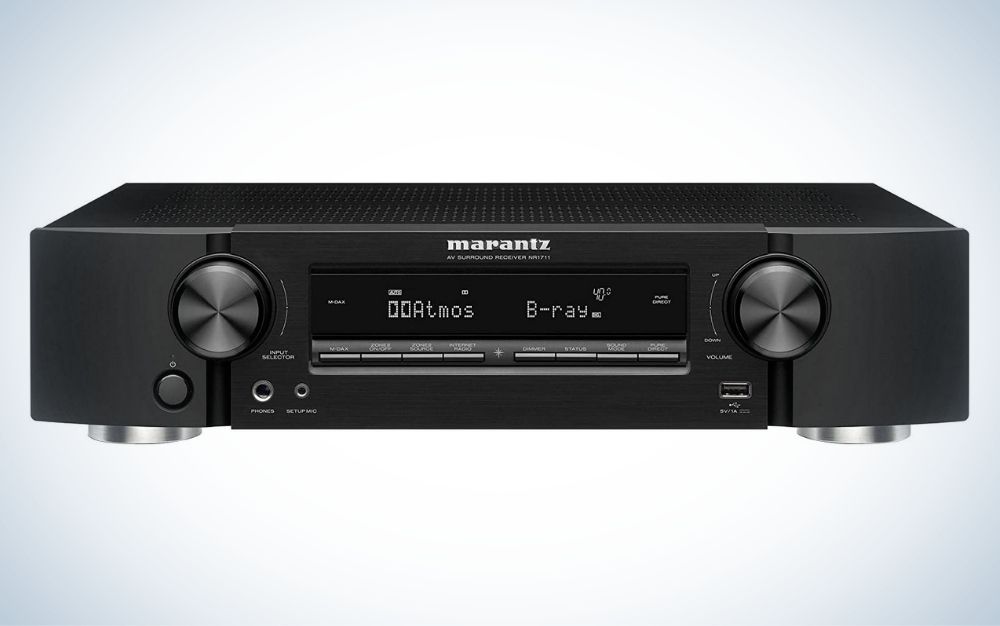 Marantz sound quality in a half-height unit that gamers will love. See It
Marantz sound quality in a half-height unit that gamers will love. See It
Pint-Sized Powerhouse
 Marantz sound quality in a half-height unit that gamers will love. See It Why it made the cut: The half-size frame and full feature set will appeal to anyone with a space-limited home theater setup.
Marantz sound quality in a half-height unit that gamers will love. See It Why it made the cut: The half-size frame and full feature set will appeal to anyone with a space-limited home theater setup.
Specs
- Channels: 7.2
- Power: 50W per channel (into 8 ohms, with 0.08 % THD, 2-ch driven)
- HDMI ports: 6in/1out (eARC)
- Highest Video Supported: 8K
Pros
- Slimline form factor saves space
- 8K support provides future-proofing
- Comprehensive implementation of Dolby and DTS multichannel formats
Cons
- Only 50W per channel
The NR1711 is a diminutive 3.5 inches in height, about half that of the typical AVR. Yet somehow, Marantz was able to engineer it with a competitive feature set for its $800 price range. Because of its half-sized housing, Marantz had to scale down the amplifier size, so its power output is only 50W per channel. But unless you’re setting it up in a large room, it should still give you plenty of oomph.
Gamers short on space will appreciate the NR1711’s “Slimline” form factor. They’ll also love its 8K support, which will serve them well for the next generation of gaming consoles like the PS5 and Xbox Series X. Home theater buffs will appreciate the impressive list of surround formats supported by the NR1711, such as Dolby Atmos, Dolby Speaker Virtualizer, Dolby Digital Plus, and Dolby Surround. DTS is also well represented with DTS:X, DTS Virtual:X, DTS Neural:X, and DTS Digital Surround, to name just some.
You can set up and calibrate your system with built-in Audyssey MultiEQ, Dynamic EQ, and Dynamic Volume processors. If you want to spin some vinyl, the NR1711 sports phono inputs alongside its other analog I/O. Additional goodies include Bluetooth, WiFi support, AirPlay 2, HEOS, and Alexa support.
Best budget: Denon AVR-S570BT
Best budget AV receiver
Surround for Less
 See It
See It
Surround for Less
 See It Why it made the cut: It offers a low-cost path into the surround-sound world.
See It Why it made the cut: It offers a low-cost path into the surround-sound world.
Specs
- Channels: 5.2
- Power: 70W per channel RMS at 8 ohms, 0.07 percent THD, two channels driven.
- HDMI ports: 4in/1out (ARC)
- Highest video Supported: 8K HDR pass-through
Pros
- Low price for a 5.2-compatible AV Receiver
- 8K video pass-through and Dolby Vision support
- Quality sonics
Cons
- No Atmos support
The Denon AVR-S570BT is an entry-level AVR that can handle Ultra-HD content such as 4K Blu-ray and HDR video, and play audio encoded in most of the latest surround sound formats. It lacks Dolby Atmos support, which will be a sticking point if you’re living on the cutting edge, but beyond that, it’s remarkably capable.
Its most impressive feature is its 8K video pass-through capability, which comes courtesy of HDMI 2.1 ports. It also impresses on the video side by supporting 4K video pass-through at 120Hz and Dolby Vision HDR, which is the format used for the latest video games and 4K video releases. Ultimately, anyone on a budget will find a lot to like about this receiver.
We mentioned the AVR-S570BT’s only audio fault earlier, but its lack of Atmos support isn’t a big deal, given the receiver’s price. It does support Dolby TrueHD and DTS-HD, so any game or film soundtrack with a 5.1 surround sound mix will sound correct. The AVR-S570BT is also compatible with Apple’s AirPlay 2 and Bluetooth for wireless music streaming.
Overall, if you’re not trying to keep up with the latest and greatest but want to watch movies or play games in 5.1 surround sound, the Denon AVR-S570BT will get you there for less without sacrificing very much.
What to consider when shopping for the best AV receivers
You have many variables to consider with a product as complex as an AVR. Some essential questions include: Can it support what I have (or want to have) in my system? How many HDMI inputs do I need to cover all my gear and have at least one leftover for expansion? Does it support the main surround format I plan to use? Does it deliver enough power per channel to give me plenty of distortion-free volume, given the size of my room? Does it offer 8K support so that I’m future-proofed? Does it have phono inputs for my turntable? Do I need to match my speakers to an AVR? The best AV receivers cover a pretty extensive range of features and prices. Look for the one that will best meet the needs of your current or planned home theater setup.
Is 8K video capability important in an AV receiver?
Right now, 8K isn’t necessary because there’s precious little 8K content available, even if you have an 8K TV. But that will likely change in the next couple of years, and if it’s important for you to watch shows and movies or play games with the best quality available, you’ll need a receiver that supports it. Fortunately, most of the products that we recommend in this article do.
How many channels do I need if I want a receiver that supports Dolby Atmos?
Atmos is a pretty “hot” format now, offering the dimension of height and the traditional directionality of surround sound to create an even more immersive sonic environment. Many movies now offer Atmos mixes, which can be spectacular. Atmos systems require a receiver with seven channels at the minimum for a hardWPT123 system, consisting of a 5.1 speaker setup with two additional Atmos ceiling-mounted speakers. If you don’t want to mount speakers in the ceiling, you could get Atmos-enabled speakers that fire forward and upward. The latter bounces the sound off your ceiling to simulate having speakers up there. (And don’t forget the speaker wire!)
Another option is an Atmos-enabled soundbar, like the Sennheiser AMBEO or the Sony HT-A7000. Such products create an Atmos-like effect from one multi-speaker device. Finally, several receivers in this roundup support Virtualized Atmos, which simulates Atmos from whatever speaker configuration you have. The soundbar and the virtualized Atmos won’t compare to hardware-based Atmos systems, but you do get some of the effects, and it’s a lot less money. DTS:X is a competitor to Atmos and gives you a similar immersive effect. It also has a simulated version, DTS Virtual:X. Again, it would be best to have a receiver or soundbar that supports it.
HDMI input and output
On the HDMI outputs on AVRs, you’ll see the letters ARC or eARC. ARC stands for Audio Return Channel and eARC (Enhanced Audio Return Channel), introduced with HDMI 2.1. Both ARC and eARC allow bidirectional audio. With the emergence of smart TVs, which stream content from the internet, you need a way to get the audio from that content out of your TV and into your AVR or soundbar so that it gets amplified and routed to speakers. If you have eARC, it supports up to 24-bit/192kHz audio, as well as uncompressed audio from 5.1 and 7.1 surround content. In addition, it works with compressed formats like Dolby Atmos and DTS-HD Master Audio coming from your TV. And don’t forget the HDMI cables!
FAQs
Q: How long do audio receivers last?The general consensus is that five years is the typical lifespan for an AVR. It’s not like it will just up and die after a certain number of years, like a water heater. Your receiver could function well for 20 years or more. But with the relentless forward march of technology, it will begin to feel like a dinosaur around the five-year mark. Even if you don’t care about staying up with the latest and greatest, there comes a time when it’s hard to resist the allure of new technology.
Q: Do receivers make a difference in sound quality?Context matters here. A dedicated power amp is superior if you’re talking about music quality. However, AV receivers are much more than just amplifiers. They’re the hub of a home theater or gaming setup (or one that does both) and offer a vast range of WPT123 and wireless connections. Incoming audio gets routed to their amplifiers and into whatever speaker system you use. AVRs can also pass the video content from streaming boxes, cable boxes, Blu-ray players, and game consoles to your television. They don’t process the video; they pass it through in whatever format it’s in, assuming it’s one they support.
Q: Are AV receivers worth it?The best AV receivers are totally worth it if you want more than just a home stereo system. Don’t get me wrong, we love the compact, self-contained nature of powered speakers. But if you’re looking to create a proper home theater for movies and/or your gaming rig, or want a music system that allows for way more sources than just streaming services, the easiest way to accommodate the diverse range of connectivity required is with an AV receiver. It takes the incoming content—whether from a streaming box, a set-top box, a gaming console, a turntable, or other physical media—processes it in the appropriate format (assuming it supports it) and sends the audio off to the speakers while sending the video through to your TV. What’s more, most AVRs offer some form of multizone audio, so if you get the appropriate speakers, you can also run audio to multiple locations in your house or apartment from your receiver.
Q: How many watts per channel do I need?While the appropriate answer is ultimately based on the recommended amplification range of your speakers, 50W-100W per channel is typically more than enough to satisfy the vast majority of surround sound speakers (75W being the sweet spot in a 5.1 or 7.1 system). That’s not to say there aren’t speakers that require a higher RMS rating, but if that’s the kind you’re looking at, you probably know you’ll need to look at higher-end AV receivers or even discrete amplification (maybe you’re even working with an integrator).
Final thoughts on the best AV receivers
- Best overall: Marantz Cinema 70S
- Best 4K under $500: Yamaha RX-4VA
- Best 7.2: Denon AVR-X2800H
- Best for home theater: Arcam AVR31
- Best for gaming: Sony STR-AN1000
- Best low profile: Marantz NR1711
- Best budget: Denon AVR-S570BT
As you may have noticed from our roundup, there are a lot of choices and a wide range of prices in the AVR market. To decide which is right for you, you need to consider the price and the kind of system you’re trying to create. Do you want to move from 5.1 to a more complex multichannel format, like a 7.1 or an Atmos system? Will you also have to upgrade your TV and speaker system to achieve your goals? Because AV receivers are multifaceted and encompass or support so many technologies, it helps to be as informed as possible when deciding which one to buy. In this article, we’ve offered you a diverse range of products and information. However, you still have plenty of issues to consider regarding the specifics of your system, the space you’re putting it in, and your goals for the system before you can choose which of the best AV receivers is best for your needs.
FAQ
Are AV processors worth it?
While the most powerful receivers can offer around 13 channels at up to around 150W in stereo, with an AV processor and power amp, you can not only up the channel ante but also increase that wattage by a considerable amount to drive all the loudspeakers and subwoofers in home cinema installs of even epic proportions.Jun 15, 2023
What is high-end AV?
High-end audio is a class of consumer home audio equipment marketed to audiophiles on the basis of high price or quality, and esoteric or novel sound reproduction technologies.
What is AV in an amplifier?
It is expensive because it’s a big chunk of the budget, but there’s a lot”, says Damian. “As you know yourself, first the equipment costs, right? Actually owning the equipment yourself, as in the AV company, owning the equipment or hiring it from another AV company costs.
What is the best AV receiver brand?
With 4K, the entire chain needs to be 4K compatible. So if you buy a new 4K TV, want to feed it 4K via HDMI sources, and want to switch those sources using an AV receiver (as opposed to the TV), you’ll need to buy a new receiver that handles those 4K sources.17 Apr 2024
Does AV support 4K?
In summary: Thanks.In summary, the designer of an amplifier describes two terms for gain - voltage gain (Av) and overall gain (Gv). Voltage gain is the ratio of the volts out over the volts in and overall gain is the gain in actual power, achieved.23 May 2010












 Join the conversation with other Anthem fans on Facebook.
Join the conversation with other Anthem fans on Facebook. Keep up with everything Anthem on Twitter.
Keep up with everything Anthem on Twitter. View & download product photos, lifestyle images and logos on Flickr.
View & download product photos, lifestyle images and logos on Flickr. Watch our information and product videos on YouTube.
Watch our information and product videos on YouTube. Get the latest news and special announcements on our official Blog.
Get the latest news and special announcements on our official Blog.
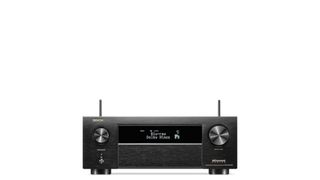 Best overall
Best overall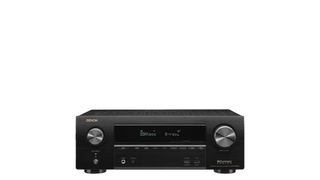 Best value
Best value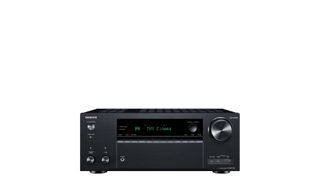 Best 4K/8K support
Best 4K/8K support Best format support
Best format support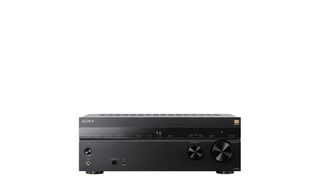 Best for spatial audio
Best for spatial audio Best low profile
Best low profile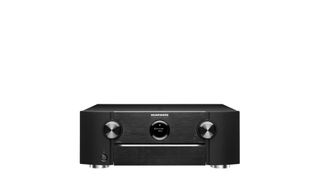 Best for audiophiles
Best for audiophiles Lee DunkleyAudio EditorHi, I’m Lee and I cover all things audio for Tom’s Guide, including maintaining buying guides on the best AV receivers, best audiophile headphones, best turntables, and best music streaming services (to name a few). I’ve been working in the consumer tech industry for more than 30 years and write about the finest audio products in the world. As an audio expert, I built my own home theater room to test AV setups including multi-channel AV receivers, speaker systems, and flatscreen TVs. As well as being fanatical about great sound with high-octane movies, I also love listening to music on components that get me closer to my favorite tracks and make a strong musical connection. I have been reviewing luxury Hi-Fi audio components since the mid-nineties, making me perfectly positioned to find the best-sounding AV receiver for all your home entertainment needs at the right budget.
Lee DunkleyAudio EditorHi, I’m Lee and I cover all things audio for Tom’s Guide, including maintaining buying guides on the best AV receivers, best audiophile headphones, best turntables, and best music streaming services (to name a few). I’ve been working in the consumer tech industry for more than 30 years and write about the finest audio products in the world. As an audio expert, I built my own home theater room to test AV setups including multi-channel AV receivers, speaker systems, and flatscreen TVs. As well as being fanatical about great sound with high-octane movies, I also love listening to music on components that get me closer to my favorite tracks and make a strong musical connection. I have been reviewing luxury Hi-Fi audio components since the mid-nineties, making me perfectly positioned to find the best-sounding AV receiver for all your home entertainment needs at the right budget.


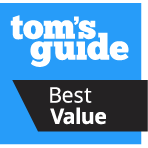



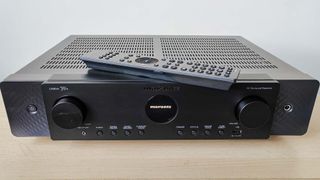
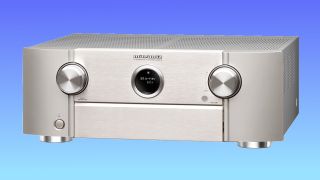
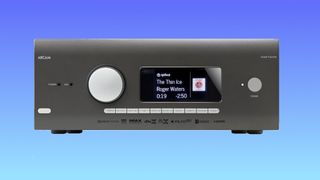

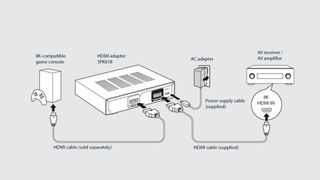
 Denon AVR-4800H
Denon AVR-4800H $2,499ViewSee all prices
$2,499ViewSee all prices Denon AVR-X2700H
Denon AVR-X2700H Onkyo TX-NR7100
Onkyo TX-NR7100 Marantz Cinema 50
Marantz Cinema 50 $898ViewSee all prices
$898ViewSee all prices Marantz Cinema 70S
Marantz Cinema 70S
